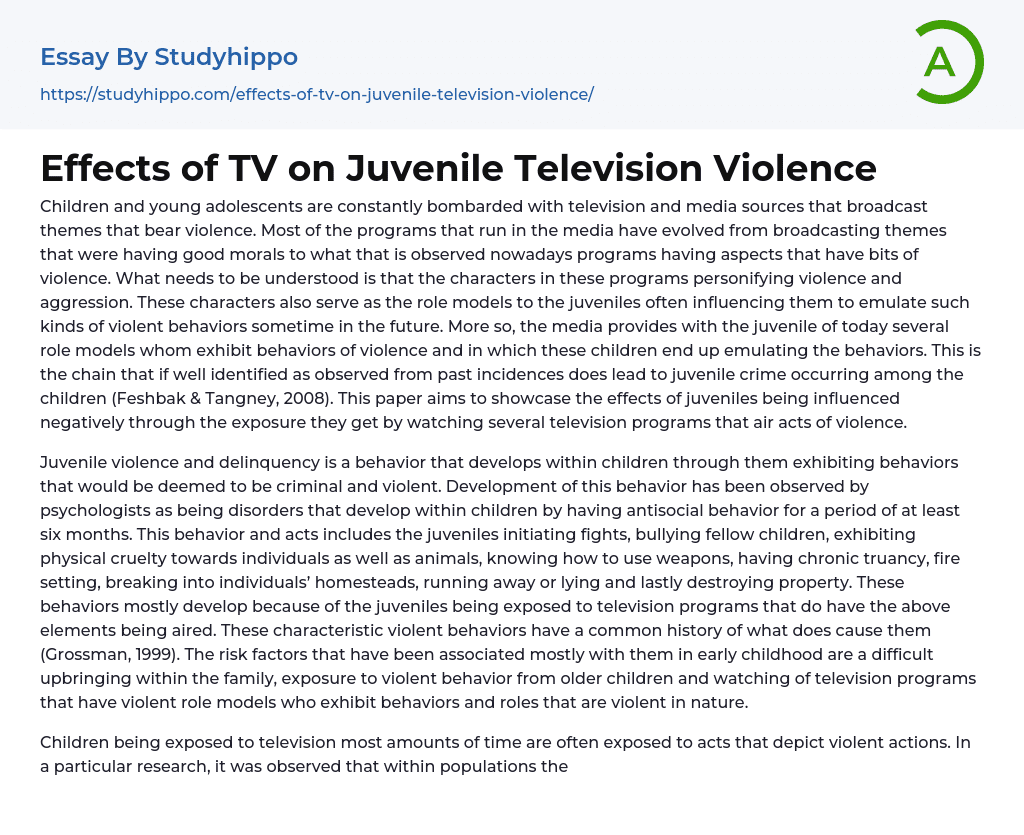

Effects of TV on Juvenile Television Violence Essay Example
Children and young adolescents are exposed to a continuous stream of violent themes through television and other media sources.
Programs in the media have transitioned from broadcasting themes of good morals to programs that contain elements of violence. It is important to understand that the characters in these programs act out violence and aggression. These characters also serve as role models for young people, who may be influenced to imitate violent behaviors in the future. Furthermore, the media provides numerous role models for today's youth, who often exhibit violent behaviors that children end up emulating. This pattern, which has been observed in past incidents, can lead to juvenile crime among children (Feshbak ; Tangney, 2008).
This paper aims to demonstrate the negative influence of television programs depicting violence on juveniles. Juvenile violence and delinquency refers to criminal and violent behavior displayed by chil
...dren. Psychologists have observed that these behaviors are disorders that develop within children who exhibit antisocial behavior for at least six months. Such behavior includes initiating fights, bullying, being physically cruel to others and animals, knowing how to use weapons, chronic truancy, fire setting, breaking into homes, running away or lying, and property destruction. These behaviors often arise as a result of exposure to television programs that contain the aforementioned elements.
The violence that characterizes these behaviors stems from a shared history (Grossman, 1999). In early childhood, risk factors commonly associated with these behaviors include a troubled upbringing, exposure to older children engaging in violence, and viewing television programs featuring violent role models. Children who spend the most time watching television are often exposed to scenes depicting violent acts. A specific study found that within certain
populations, some children would go to extreme lengths, such as committing suicide, in order to have their images broadcast on television.
Due to such actions, modern televisions do not usually cover suicides in an attempt to reduce daily suicide rates. In some cases, children exposed to violent scenes on television gradually develop aggressive behaviors and can become violent. This leads to the formation of copycat clusters and transforms these children into offenders capable of committing any form of crime or violence due to constant exposure from television sets (Heath et al., 1986). Research has focused on understanding how television viewing influences aggressive behavior among different races and ethnicities, but no correlation has been found implicating specific races as being more influenced by television and later exhibiting violent behavior. Psychologists recommend preventing chronic delinquency in order to combat violent behavior in children, thereby understanding the underlying factors causing it during early childhood.According to Redding (2003), several factors contribute to the occurrence of various issues. These factors comprise perinatal challenges, biological and neurological conditions, living in socially disorganized and violent neighborhoods, inconsistent or tough parenting methods, substance abuse, parental criminality, and exposure to media violence.
Media exposure is the primary way that young people are exposed to crime scenes, and parents and caregivers must learn how to discourage antisocial behavior. One way is by reinforcing common aversive behaviors like noncompliance, tantrums, and teasing. It is important to note that the relationship between exposure to media violence and aggressive behavior has been studied extensively, with field experiments, laboratory experiments, and quasi-experiments all demonstrating this connection. Most studies have found that the link between media and aggression is heightened when the
aggression in the media is justified, there are noticeable cues during retrieval, individuals are predisposed to aggression, and respondents identify with violent characters (Yoshikawa, 1994).
Although not all television shows watched by juveniles include exposure to media violence, there are educational programs available featuring positive characters who can act as role models for young viewers. Age-appropriate programs designed specifically for juveniles offer beneficial content that aids in their development. These programs counteract the presence of violent behavior in other shows, giving juveniles an opportunity to interact with educational and friendly content that encourages positive actions. It is important to mention that not all media programs contain violent elements.
The media plays a crucial role in shaping the perception of the world for young children by showing them things and phenomena they may not encounter otherwise. This exposure during their formative years helps them understand reality and how the world functions, without relying on violent programs. In summary, the media and television greatly influence the behavior and character development of young individuals.
There are certain programs that, when viewed by juveniles, lead them to develop aggressive and violent behavior towards their peers. It is important for juveniles to avoid these types of programs as they hinder their developmental processes. Instead, they should be influenced by educational programs that are age-appropriate and feature positive role models who promote good values and relationships with others.
References
- Feshbach, S., ; Tangney, J. (2008). Television viewing and aggression: Some alternative perspectives. Perspectives on Psychological Science
- Grossman, D. (1999). WE ARE TRAINING OUR KIDS TO KILL. Saturday Evening Post
- Heath, L., Kruttschnitt, C., ; Ward, D. (1986).
Television and violent criminal behavior: Beyond the bobo doll. Violence and Victims.
Redding,
R. E. (2003). The Effects of Adjudicating and Sentencing Juveniles as Adults Research and Policy Implications.
Youth media violence and juvenile justice,
- Yoshikawa, H. (1994). Prevention as cumulative protection and excessive use of media: effects of early family support and education on chronic delinquency and its risks. Psychological bulletin



